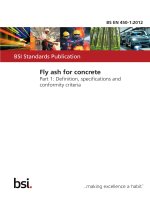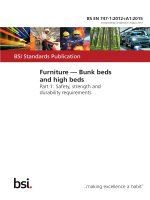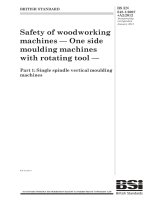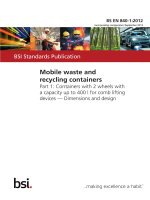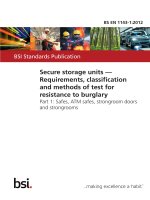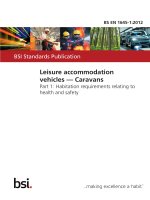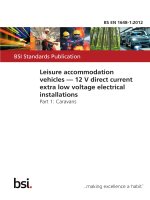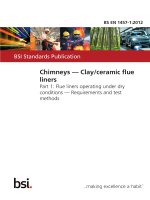Bsi bs en 61375 1 2012
Bạn đang xem bản rút gọn của tài liệu. Xem và tải ngay bản đầy đủ của tài liệu tại đây (1.45 MB, 54 trang )
BS EN 61375-1:2012
BSI Standards Publication
Electronic railway equipment
— Train communication
network (TCN)
Part 1: General architecture
BRITISH STANDARD
BS EN 61375-1:2012
National foreword
This British Standard is the UK implementation of EN 61375-1:2012.
It is identical to IEC 61375-1:2012.
The UK participation in its preparation was entrusted by Technical Committee
GEL/9, Railway Electrotechnical Applications, to Panel GEL/9/-/4, Railway
applications - Train communication network and multimedia systems.
A list of organizations represented on this committee can be obtained on
request to its secretary.
This publication does not purport to include all the necessary provisions of a
contract. Users are responsible for its correct application.
© The British Standards Institution 2012
Published by BSI Standards Limited 2012
ISBN 978 0 580 68226 1
ICS 45.060
Compliance with a British Standard cannot confer immunity
from legal obligations.
This British Standard was published under the authority of the
Standards Policy and Strategy Committee on 31 August 2012.
Amendments issued since publication
Amd. No.
Date
Text affected
BS EN 61375-1:2012
EUROPEAN STANDARD
EN 61375-1
NORME EUROPÉENNE
EUROPÄISCHE NORM
August 2012
ICS 45.060
English version
Electronic railway equipment Train communication network (TCN) Part 1: General architecture
(IEC 61375-1:2012)
Matériel électronique ferroviaire Réseau embarqué de train (TCN) Partie 1: Architecture générale
(CEI 61375-1:2012)
Elektronische Betriebsmittel für Bahnen Zug-Kommunikations-Netzwerk (TCN) Teil 1: Allgemeiner Aufbau
(IEC 61375-1:2012)
This European Standard was approved by CENELEC on 2012-07-26. CENELEC members are bound to comply
with the CEN/CENELEC Internal Regulations which stipulate the conditions for giving this European Standard
the status of a national standard without any alteration.
Up-to-date lists and bibliographical references concerning such national standards may be obtained on
application to the CEN-CENELEC Management Centre or to any CENELEC member.
This European Standard exists in three official versions (English, French, German). A version in any other
language made by translation under the responsibility of a CENELEC member into its own language and notified
to the CEN-CENELEC Management Centre has the same status as the official versions.
CENELEC members are the national electrotechnical committees of Austria, Belgium, Bulgaria, Croatia, Cyprus,
the Czech Republic, Denmark, Estonia, Finland, Former Yugoslav Republic of Macedonia, France, Germany,
Greece, Hungary, Iceland, Ireland, Italy, Latvia, Lithuania, Luxembourg, Malta, the Netherlands, Norway, Poland,
Portugal, Romania, Slovakia, Slovenia, Spain, Sweden, Switzerland, Turkey and the United Kingdom.
CENELEC
European Committee for Electrotechnical Standardization
Comité Européen de Normalisation Electrotechnique
Europäisches Komitee für Elektrotechnische Normung
Management Centre: Avenue Marnix 17, B - 1000 Brussels
© 2012 CENELEC -
All rights of exploitation in any form and by any means reserved worldwide for CENELEC members.
Ref. No. EN 61375-1:2012 E
BS EN 61375-1:2012
EN 61375-1:2012
Foreword
The text of document 9/1641/FDIS, future edition 3 of IEC 61375-1, prepared by IEC/TC 9 "Electrical
equipment and systems for railways" was submitted to the IEC-CENELEC parallel vote and approved by
CENELEC as EN 61375-1:2012.
The following dates are fixed:
•
•
latest date by which the document has
to be implemented at national level by
publication of an identical national
standard or by endorsement
latest date by which the national
standards conflicting with the
document have to be withdrawn
(dop)
2013-04-26
(dow)
2015-07-26
Attention is drawn to the possibility that some of the elements of this document may be the subject of
patent rights. CENELEC [and/or CEN] shall not be held responsible for identifying any or all such patent
rights.
This document has been prepared under a mandate given to CENELEC by the European Commission
and the European Free Trade Association, and supports essential requirements of EU Directive(s).
For the relationship with EU Directive(s) see informative Annex ZZ, which is an integral part of this
document.
Endorsement notice
The text of the International Standard IEC 61375-1:2012 was approved by CENELEC as a European
Standard without any modification.
In the official version, for Bibliography, the following notes have to be added for the standards indicated:
IEC 61375-2-1
NOTE Harmonized as EN 61375-2-1.
IEC 61375-3-1
NOTE Harmonized as EN 61375-3-1.
BS EN 61375-1:2012
EN 61375-1:2012
Annex ZA
(normative)
Normative references to international publications
with their corresponding European publications
The following documents, in whole or in part, are normatively referenced in this document and are
indispensable for its application. For dated references, only the edition cited applies. For undated
references, the latest edition of the referenced document (including any amendments) applies.
NOTE When an international publication has been modified by common modifications, indicated by (mod), the relevant EN/HD
applies.
Publication
Year
Title
EN/HD
Year
ISO/IEC 7498-1
-
Information technology - Open Systems
Interconnection - Basic Reference Model:
The Basic Model
-
-
ISO/IEC 8824-1
2002
Information technology - Abstract Syntax
Notation One (ASN.1): Specification of basic
notation
-
ISO/IEC 9646-1
1994
Information technology - Open Systems
Interconnection - Conformance testing
methodology and framework Part 1: General concepts
-
-
ISO/IEC 19501
2005
Information technology - Open Distributed
Processing - Unified Modeling Language
(UML)
-
-
UIC CODE 556
-
Information transmission in the train (trainbus)
-
-
BS EN 61375-1:2012
EN 61375-1:2012
Annex ZZ
(informative)
Coverage of Essential Requirements of EU Directives
This European Standard has been prepared under a mandate given to CENELEC by the European
Commission and the European Free Trade Association and within its scope the standard covers all
relevant essential requirements as given in Annex III of the EU Directive 2008/57/EC.
Compliance with this standard provides one means of conformity with the specified essential
requirements of the Directive concerned.
WARNING: Other requirements and other EU Directives may be applicable to the products falling within
the scope of this standard.
BS EN 61375-1:2012
61375-1 IEC:2012
CONTENTS
INTRODUCTION . .................................................................................................................................. 7
1
Scope . ............................................................................................................................................. 8
2
Normative references. ................................................................................................................... 8
3
Terms, definitions, abbreviated terms, acronyms, and conventions . ....................................... 8
3.1
3.2
3.3
4
Terms and definitions . ........................................................................................................ 8
Abbreviations and acronyms ............................................................................................ 15
Conventions ....................................................................................................................... 16
3.3.1 Requirement conventions .................................................................................... 16
3.3.2 Base of numeric values . ...................................................................................... 16
3.3.3 Naming conventions............................................................................................. 16
3.3.4 State diagram conventions . ................................................................................ 16
Basic architecture ........................................................................................................................ 16
4.1
4.2
Contents of this clause ..................................................................................................... 16
General . ............................................................................................................................. 16
4.2.1 Technology classes ............................................................................................. 16
4.2.2 Component types . ................................................................................................ 17
4.3
5
Hierarchical structure . ....................................................................................................... 17
4.3.1 Network levels ...................................................................................................... 17
4.3.2 Train backbone level ............................................................................................ 17
4.3.3 Consist network level . ......................................................................................... 18
4.3.4 Interface between train backbone and consist network . ................................. 18
4.3.5 End devices connected to train backbone ......................................................... 19
4.4 Network configurations ..................................................................................................... 19
4.5 Train to ground connection (option) . ............................................................................... 20
Train backbone . ........................................................................................................................... 21
5.1
5.2
6
Contents of this clause ..................................................................................................... 21
Train backbone topology . ................................................................................................. 21
5.2.1 General . ................................................................................................................ 21
5.2.2 Train backbone based on bus technology ......................................................... 21
5.2.3 Train backbone based on switched technology ................................................ 22
5.3 Train compositions . .......................................................................................................... 22
5.4 Train backbone node numbering . .................................................................................... 23
5.5 Train directions . ................................................................................................................. 23
5.5.1 Vehicle . ................................................................................................................. 23
5.5.2 Consist . ................................................................................................................. 23
5.5.3 Closed train . ......................................................................................................... 24
5.5.4 Train ....................................................................................................................... 24
5.6 Train inauguration .............................................................................................................. 26
5.6.1 Objectives ............................................................................................................. 26
5.6.2 Train network directory . ...................................................................................... 26
5.6.3 Inauguration control ............................................................................................. 28
5.6.4 Node states . ......................................................................................................... 29
5.6.5 Node roles ............................................................................................................. 32
5.6.6 Performance . ........................................................................................................ 32
Consist network . .......................................................................................................................... 32
BS EN 61375-1:2012
61375-1 IEC:2012
6.1
Contents of this clause ..................................................................................................... 32
6.2
6.3
7
Scope of standardization. ................................................................................................. 32
Consist network topology . ................................................................................................ 33
6.3.1 Consist network based on bus technology (MVB, CANopen) . ........................ 33
6.3.2 Consist network based on switched technology ............................................... 34
6.3.3 Sub-networks . ....................................................................................................... 36
6.3.4 Heterogeneous consist network . ....................................................................... 36
6.4 Gateway . ............................................................................................................................ 36
6.4.1 General . ................................................................................................................ 36
6.4.2 Functional description . ........................................................................................ 37
6.4.3 Application layer gateway .................................................................................... 37
6.4.4 Gateway implemented by a router . .................................................................... 39
On-board data communication . ................................................................................................. 39
7.1
7.2
General . ............................................................................................................................. 39
Communication patterns . ................................................................................................. 39
7.3
7.2.1 Purpose . ................................................................................................................ 39
7.2.2 Definitions ............................................................................................................. 39
7.2.3 Push pattern . ........................................................................................................ 40
7.2.4 Pull pattern . .......................................................................................................... 41
7.2.5 Subscription pattern ............................................................................................. 43
Addressing . ........................................................................................................................ 43
7.4
7.5
7.3.1 General . ................................................................................................................ 43
7.3.2 Network layer addressing .................................................................................... 43
7.3.3 Application layer addressing . .............................................................................. 45
Availability of data communication . ................................................................................ 45
Data classes ....................................................................................................................... 46
7.5.1 General . ................................................................................................................ 46
7.5.2 Service parameters . ............................................................................................. 46
7.5.3 TCN data class definition .................................................................................... 47
7.6 Communication profile ...................................................................................................... 48
Bibliography ......................................................................................................................................... 49
Figure 1 – Train backbone and consist network . ............................................................................ 17
Figure 2 – Consist with two consist networks . ................................................................................ 18
Figure 3 – End device connected to the train backbone (example) . ............................................ 19
Figure 4 – Communication between train and ground (example) . ................................................ 21
Figure 5 – Interfaces between consists ............................................................................................ 21
Figure 6 – Train backbone bus topology . ........................................................................................ 22
Figure 7 – Train backbone switched topology . ............................................................................... 22
Figure 8 – Directions and orientation in a vehicle ........................................................................... 23
Figure 9 – Directions and orientations in a consist . ....................................................................... 24
Figure 10 – Directions and orientations in a closed train . ............................................................. 24
Figure 11 – Directions and orientations in train (TCN directions) . ................................................ 25
Figure 12 – Structure of train network directory (example) . .......................................................... 27
Figure 13 – Train inauguration block diagram . ............................................................................... 30
Figure 14 – Train inauguration state chart . ..................................................................................... 31
Figure 15 – Consist network standard interfaces . ........................................................................... 33
BS EN 61375-1:2012
61375-1 IEC:2012
Figure 16 – Consist network (bus technology) . ............................................................................... 34
Figure 17 – Consist switches ............................................................................................................. 34
Figure 18 – Examples of consist network topologies (switched technology) . .............................. 35
Figure 19 – End Device connected to two consist switches . ......................................................... 35
Figure 20 – Sub-networks in a consist network . ............................................................................. 36
Figure 21 – Implementation example for two vehicle busses ........................................................ 36
Figure 22 – Example of heterogeneous train control network architecture . ................................ 37
Figure 23 – Local service . ................................................................................................................. 38
Figure 24 – Unconfirmed service ...................................................................................................... 38
Figure 25 – Confirmed service . ......................................................................................................... 38
Figure 26 – Provider initiated services ............................................................................................. 39
Figure 27 – Point to point communication pattern (push) . ............................................................. 40
Figure 28 – Point to multi-point communication pattern (push) . ................................................... 41
Figure 29 – Point to point communication pattern (pull) ................................................................. 41
Figure 30 – Point to multi-point communication pattern (push) . ................................................... 42
Figure 31 – Subscription communication pattern . ........................................................................... 43
Table 1 – Train composition changes . ............................................................................................. 22
Table 2 – Train network specific parameters (example) . .............................................................. 27
Table 3 – Consist network specific parameters (example) . ........................................................... 27
Table 4 – Vehicle specific parameters (example) ........................................................................... 28
Table 5 – Device specific parameters (example) . ........................................................................... 28
Table 6 – Service parameters . .......................................................................................................... 46
Table 7 – Principal data classes . ...................................................................................................... 47
BS EN 61375-1:2012
61375-1 IEC:2012
–7–
INTRODUCTION
IEC 61375-1 defines the general architecture of the Train Communication Network (TCN) so as
to achieve compatibility between consist networks defined by this part of IEC 61375 and train
backbones defined by this part of IEC 61375.
The TCN has a hierarchical structure with two levels of networks, a train backbone and a
consist network:
a) for interconnecting vehicles in close or open trains, this part of IEC 61375 specifies train
backbones with different characteristics;
b) for connecting standard on-board equipment, this part of IEC 61375 specifies consist
networks with different characteristics.
The general architecture of the TCN, which is defined in this part of the standard, shall
c) establish the rules for interconnecting consist networks with train backbones, as
•
identifying the interfaces;
•
defining the principles of how train topology changes can be discovered;
•
defining the basic communication services provided by train backbones to be used by
consist networks;
d) establish basic rules for the train backbone and for the consist network;
e) establish rules for communalities in operation, as:
•
patterns for the communication between users;
•
addressing principles;
•
data classes to be supported.
–8–
BS EN 61375-1:2012
61375-1 IEC:2012
ELECTRONIC RAILWAY EQUIPMENT –
TRAIN COMMUNICATION NETWORK (TCN) –
Part 1: General architecture
1
Scope
This part of IEC 61375 applies to the architecture of data communication systems in open
trains, i.e. it covers the architecture of a communication system for the data communication
between vehicles of the said open trains, the data communication within the vehicles and the
data communication from train to the ground.
The applicability of this part of IEC 61375 to the train network technologies allows for
interoperability of individual vehicles within open trains in international traffic. The data
communication systems inside vehicles are given as recommended solutions to cope with the
said TCN. In any case, proof of compatibility between a proposed train backbone and a
proposed consist network will have to be brought by the supplier.
This part of IEC 61375 may be additionally applicable to closed trains and multiple unit trains
when so agreed between purchaser and supplier.
NOTE 1
For a definition of open trains, multiple unit trains and closed trains, see Clause 3.
NOTE 2
Road vehicles such as buses and trolley buses are not considered in this part of IEC 61375.
2
Normative references
The following documents, in whole or in part, are normatively referenced in this document and
are indispensable for its application. For dated references, only the edition cited applies. For
undated references, the latest edition of the referenced document (including any amendments)
applies.
ISO/IEC 7498-1, Information Technology – Open Systems Interconnection – Basic Reference
Model: The Basic Model
ISO/IEC 8824-1:2002, Information technology – Abstract Syntax Notation One (ASN.1):
specification of basic notation
ISO/IEC 9646-1:1994, Information technology – Open Systems Interconnection – Conformance
testing methodology and framework – Part 1: General concepts
ISO/IEC 19501:2005, Information technology – Open Distributed Processing – Unified Modeling
Language (UML) Version 1.4.2
UIC CODE 556, Information transmission in the train (train-bus)
3
3.1
Terms, definitions, abbreviated terms, acronyms, and conventions
Terms and definitions
For the purposes of this document, the following terms and definitions apply.
BS EN 61375-1:2012
61375-1 IEC:2012
–9–
3.1.1
active train backbone node
train backbone node receiving a sequence number during inauguration and forwarding user
data packets between consist network and train backbone
3.1.2
application layer
upper layer in the OSI model, interfacing directly to the Application
3.1.3
application layer interface
definition of the services offered by the application layer
3.1.4
application process
an element within a real open system which performs the information processing for a
particular application
3.1.5
bridge
device which stores and forwards frames from one bus to another on the base of their link
layer addresses
3.1.6
broadcast
nearly simultaneous transmission of the same information to several destinations. Broadcast in
the TCN is not considered reliable, i.e. some destinations may receive the information and
others not
3.1.7
bus
communication medium which broadcasts the same information to all attached participants at
nearly the same time, allowing all devices to obtain the same sight of its state, at least for the
purpose of arbitration
3.1.8
closed train
train composed of one or a set of consists, where the composition does not change during
normal operation, for instance metro, sub-urban train, or high speed train units
EXAMPLE
Consists are coupled in a workshop to establish a closed train for operation.
3.1.9
communication devices
devices connected to consist network or train backbone with the ability to transport, source or
sink data
3.1.10
composition
number and characteristics of the vehicles forming a train
3.1.11
configuration
definition of the topology of a network, the devices connected to it, their capabilities and the
traffic they produce; by extension, the operation of loading the devices with the configuration
information before going to regular operation
– 10 –
BS EN 61375-1:2012
61375-1 IEC:2012
3.1.12
consist
train set
rake of coaches
single vehicle or a group of vehicles which are not separated during normal operation, and
which contains no, one or several consist networks
EXAMPLE The vehicles of a consist are steadily connected in a workshop, and automatic couplers
are mounted at both ends of the consist to facilitate the coupling and de-coupling of complete consists
in the workshop or during operation.
3.1.13
consist network
communication network interconnecting communication devices in one consist
NOTE
Consist networks do not spread beyond consist boundaries.
3.1.14
consist network address
network address, which does not change after inauguration and which is used to address
communication device in the own consist network
3.1.15
consist sequence number
sequence number of the consist in the train as obtained during train inauguration
3.1.16
consist switch
consist network node
network component used in consist network based on switched technology (ECN). See “switch”
3.1.58.
3.1.17
consumer
receiver of a message at the transport layer (see: “producer” 3.1.47)
3.1.18
destination device
receiver of a data packet (see: “source device” 3.1.55 )
3.1.19
end device
unit connected to one consist network or to one set of consist networks prepared for
redundancy reasons
3.1.20
end node
node which terminates the train backbone
3.1.21
function
application process which exchanges messages with another application process
3.1.22
gateway
connection between different communication technologies
BS EN 61375-1:2012
61375-1 IEC:2012
– 11 –
3.1.23
group address
address of a multicast group to which a device belongs
3.1.24
inauguration
operation executed in case of composition change, which gives all nodes of the train backbone
their train backbone address, their orientation and information about all named nodes on the
same backbone
3.1.25
integrity
property of a system to recognize and to reject wrong data in case of malfunction of its parts
3.1.26
intermediate node
node which establishes continuity between two bus sections connected to it, but does not
terminate them
3.1.27
jumper cable
cable connecting the trunk cables of two consecutive vehicles, possibly of a larger crosssection than the trunk cable, and which is plugged by hand in the case of the UIC-cable. There
are generally two jumper cables between vehicles
3.1.28
linear topology
topology where the nodes are connected in series, with two nodes each connected to only one
other node and all others each connected to two other nodes (that is, connected in the shape
of a line)
[IEC 61784-2]
3.1.29
local area network
part of a network characterized by a common medium access and address space
3.1.30
medium access control
sublayer of the link layer, which controls the access to the medium (arbitration, mastership
transfer, polling)
3.1.31
medium
physical carrier of the signal: electrical wires, optical fibers, etc.
3.1.32
message
data item transmitted in one or several packets
3.1.33
mobile train unit
part of a train which shall be uniquely addressable from ground. A mobile train unit provides
one active mobile communication gateway for train to ground communication.
– 12 –
BS EN 61375-1:2012
61375-1 IEC:2012
3.1.34
multicast
transmission of the same message to a group of receivers, identified by their group address;
the word "multicast" is used even if the group includes all receivers
3.1.35
multiple unit train
a train consisting of a set of closed trains, where the composition of the set may change during
normal operation
3.1.36
network
set of possibly different communication systems which interchange information in a commonly
agreed way
3.1.37
network address
address which identifies a communication device on network layer
3.1.38
network device
components used to set up consist networks and train networks. These may be passive
components like cables or connectors, active unmanaged components like repeaters, media
converters or (unmanaged) switches, or managed active components like gateways, routers
and (managed) switches.
3.1.39
network layer
layer in the OSI model responsible for routing between different busses
3.1.40
network management
operations necessary to remotely configure, monitor, diagnose and maintain the network
3.1.41
node
device on the train backbone, which may act as a gateway between train backbone and consist
network
3.1.42
octet
byte
8-bit word stored in memory or transmitted as a unit
3.1.43
open train
train composed of one or a set of consists, where the configuration may change during
operation, as for instance locomotive hauled international UIC trains
3.1.44
operator
enterprise or organization which is operating trains
3.1.45
packet
unit of a message (information, acknowledgement or control) transmitted by protocols on
network or transport layer
BS EN 61375-1:2012
61375-1 IEC:2012
– 13 –
3.1.46
passive train backbone node
train backbone node which is in standby to an active train backbone node in a consist network
3.1.47
producer
sender of a message at the transport layer (see: “consumer” 3.1.17)
3.1.48
publisher
source of a dataset for broadcasting (see: “subscriber” 3.1.57)
3.1.49
receiver
electronic device which may receive signals from the physical medium
3.1.50
repeater
connection at the physical layer between bus segments, providing an extension of the bus
beyond the limits permitted by passive means. The connected segments operate at the same
speed and with the same protocol. The delay introduced by a repeater is in the order of one bit
duration
3.1.51
residual error rate
probability of integrity breach (unrecognized wrong bit) per transmitted bit
3.1.52
ring topology
active network where each node is connected in series to two other nodes
[IEC 61918]
NOTE
Ring may also be referred to as loop.
3.1.53
router
connection between two busses at the network layer, which forwards datagrams from one bus
to another on the base of their network address
3.1.54
service
capabilities and features of a sub-system (e.g. a communication layer) provided to a user
3.1.55
source device
sender of a data packet (see: “destination device” 3.1.18)
3.1.56
sporadic data
transmission of data on a demand basis
3.1.57
subscriber
one of the sinks of a broadcast dataset (see: “publisher” 3.1.48)
– 14 –
BS EN 61375-1:2012
61375-1 IEC:2012
3.1.58
switch
MAC bridge as defined in IEEE 802.1D
3.1.59
topography
data structure describing the nodes attached to the train backbone, including their address,
orientation, position and node descriptor
3.1.60
topology
possible cable interconnection and number of devices in a given network
3.1.61
topography counter
counter in a node which is incremented at each new inauguration
3.1.62
train
composition of one or a set of consists, which can be operated as an autonomous unit, e.g.
containing drives and at least one driver’s cab. Trains can be categorized into open trains (see
3.1.43), closed trains (see 3.1.8) and multiple unit trains (see 3.1.35).
3.1.63
train communication network
data communication network for connecting programmable electronic equipment on-board rail
vehicles
3.1.64
train backbone
bus connecting the vehicles of a train and which conforms to the TCN protocols
3.1.65
train backbone node
node
device connected to the train backbone. A train backbone node can be used to connect end
devices or consist networks to the train backbone. A train backbone node can be active (see
3.1.1) or passive (see 3.1.46).
3.1.66
train backbone node number
node address
node number
Each active train backbone node is assigned a number during inauguration, which indicates the
position of the train backbone node on the train backbone.
3.1.67
train network address
dynamic network address, which is used to address communication devices in other consist
networks. This address can change after each inauguration.
3.1.68
train network management
services of the network management for TCN
3.1.69
transport layer
layer of the OSI model responsible for end-to-end flow control and error recovery
BS EN 61375-1:2012
61375-1 IEC:2012
3.2
– 15 –
Abbreviations and acronyms
ANSI
American National Standard Institute, a standardisation body in the United States
ALG
Application Layer Gateway
BER
Bit Error Rate, the rate of bit errors in a data stream, mainly caused by noise
(random bit errors), but also caused by memory defects in data storing devices
(systematic bit errors).
BR
Bit Rate, the rate of data throughput on the medium expressed in bits per second
(bit/s) or in hertz (Hz), whichever is appropriate
CAN
Controller Area Network
CN
Consist Network
CPS
Communication Protocol Stack
CRC
Cyclic Redundancy Check, a data integrity check based on polynomial division
DIN
Deutsches Institut für Normung, the German national standardisation body
ECN
Ethernet Consist Network
ED
End Device
EIA
Electronics Industries Association, a standardisation body in the United States
ETB
Ethernet Train Backbone
IEC
International Electrotechnical Commission, Geneva
IEEE
Institute of Electrical and Electronics Engineers, New York
IETF
Internet Engineering Task Force
IP
Internet Protocols, as defined by the IETF
ISO
International Standard Organisation, Geneva
ITU
International Telecommunication Union, the international standardisation body for
telecommunications based in Geneva
MAC
Medium Access Control, a sub-layer within the Link Layer ruling which device is
entitled to send on the bus
MCG
Mobile Communication Gateway
MTU
Mobile Train Unit
MVB
Multifunction Vehicle Bus
ND
Network Device
OSI
Open System Interconnection, a universal communication model defined in
ISO/IEC 7498-1
PCTR
Protocol Conformance Test Report, defined in ISO/IEC 9646-1
PICS
Protocol Implementation Conformance Statement, defined in ISO/IEC 9646-1
RFC
Request For Comments, Internet Standard published by the IETF
TB
Train Backbone
TBN
Train Backbone Node
TCN
Train Communication Network, a set of communicating vehicle and Train
Backbones
UIC
International Union of Railways, the international railways operators association
URI
Uniform Resource Identifier, as defined by the IETF
UML
Unified Modeling Language, defined in ISO/IEC 19501.
WTB
Wire Train Bus
– 16 –
3.3
BS EN 61375-1:2012
61375-1 IEC:2012
Conventions
3.3.1
Requirement conventions
Shall
is used to describe requirements.
Should
is used to describe recommendations.
May
is used to describe acceptable features.
Could
is used to describe possible ways.
3.3.2
Base of numeric values
This part of IEC 61375 uses a decimal representation for all numeric values unless otherwise
noted.
Analog and fractional values include a comma.
EXAMPLE
The voltage is 20,0 V.
Binary and hexadecimal values are represented using the ASN.1 (ISO/IEC 8824-1) convention.
EXAMPLE
3.3.3
Decimal 20 coded on 8 bits = ‘0001 0100’B = ‘14’H.
Naming conventions
If the keyword name is composed, the different parts of the name are united with a space.
EXAMPLES “train backbone”, “consist”, “consist network”
Parameters are written with a capital letter at the beginning.
If the parameter name is composed, the different parts of the name are united without a space,
and all parts are beginning with a capital letter.
EXAMPLE “NumberOfConsists“
Function names are written with a lower case letter at the beginning.
If the function name is composed, the different parts of the name are united without a space,
and all parts except the first part are beginning with a capital letter.
EXAMPLE “indicateTopoChange“
3.3.4
State diagram conventions
State diagrams are defined following the notation of UML state machines.
4
Basic architecture
4.1
Contents of this clause
This clause specifies the hierarchical network architecture of the train communication network
together with the main characteristics of its parts and the interfaces in between.
4.2
4.2.1
General
Technology classes
This part of IEC 61375 defines a set of network technologies which can be used, either solely
or in combination, to set up the train communication network. These network technologies can
be classified in two technology classes: either the bus technology class (WTB, MVB, CANopen)
or the switched technology class (ETB, ECN). The bus technology class is characterized by
BS EN 61375-1:2012
61375-1 IEC:2012
– 17 –
having multiple end devices connected to the same data transmission media, forming one
broadcast and one collision domain. In the switched technology class is one end device
connected to a switch, which is responsible to actively forward user data inside the network. A
switched technology based network has the possibility to restrict broadcast and collision
domains.
4.2.2
Component types
The TCN is set up by two types of communication devices: network devices (ND) and end
devices (ED). Network devices are all those devices whose primary use is to transport and
forward user data. Examples of network devices are passive components like cables and
connectors or active components like repeaters, bridges, switches, routers or application layer
gateways. End devices on the other hand provide typically the sources and sinks of user data.
Examples of end devices are controllers, displays or sub-systems.
NOTE There might also be devices which provide both functions of network devices and functions of end devices,
e.g. network devices providing diagnostic information or network topology information. These devices are
sometimes called “hybrid” devices. The main determination of a device should define whether it is referred to as
network device or end device.
4.3
Hierarchical structure
4.3.1
Network levels
This part of IEC 61375 defines the architecture of the TCN as a hierarchy of two network
levels, a train backbone level and a consist network level, as shown in Figure 1.
train backbone
train
backbone
level
TBN
consist
network
level
ED
ED
TBN
TBN
consist network
ED
ED
ED
ED
ED
consist
network
level
consist network
consist network
end devices
train
backbone
level
ED
ED
ED
end devices
ED
ED
end devices
Figure 1 – Train backbone and consist network
The communication between consist networks shall be only possible over the train backbone.
NOTE
This two level architecture has been selected for the following reasons:
–
The communication network which is set-up by the consist network is a static, preconfigured network. In
opposite to that is the communication network, which is set-up by the train backbone, a dynamic network,
which changes its topology each time there is a change in the train composition. Communication between train
backbone nodes may be interrupted if a reconfiguration of the train backbone happens. During times of
unavailability of the train backbone communication the consist network communication shall not be affected.
–
A break-down of a consist network shall not (e.g. due to power loss in the consist) compromise the
communication between other consists of the same train.
–
The train backbone cannot be loaded with all the data traffic in a train, therefore intra-consist data shall be kept
local to the consist. Only data traffic directed to other consists shall be transported over the train backbone.
4.3.2
Train backbone level
On train backbone level, the train backbone interconnects the train backbone nodes (TBN)
which are located in the consists constituting the train.
Each consist could have 0, 1 or more train backbone nodes.
A more detailed specification of the train backbone is given in Clause 5.
BS EN 61375-1:2012
61375-1 IEC:2012
– 18 –
4.3.3
Consist network level
On consist network level, the consist networks interconnect end devices which are located in
one consist. A consist may contain no, one or several consist networks as depicted in Figure 2
as an example of a consist with two consist networks.
consist
train backbone
TBN
TBN
consist
network 1
ED
ED
consist
network n
ED
end devices
of consist network 1
ED
ED
ED
end devices
of consist network n
Figure 2 – Consist with two consist networks
A specific end device shall be connected to one consist network. A specific end device could
be connected to a set of consist networks in case of consist network redundancy (see 4.3.4).
NOTE End Devices could connect to multiple consist networks via different interfaces on the device. One physical
device can contain logically two or more end devices in it.
The consist networks in a consist shall be identified by a consecutive consist network number
with start value = 1.
EXAMPLE
The consist in Figure 2 contains two consist networks with number 1 and number 2.
If the consist belongs to a closed train, the consist networks in the closed train shall be
identified by an consecutive closed train network number with start value = 1.
EXAMPLE
In a closed train composed of two consists with each containing two consist networks are the consist
networks numbered from 1 to 2 in each consist, and from 1 to 4 in the closed train.
A more detailed specification of the consist network is given in Clause 6.
4.3.4
Interface between train backbone and consist network
A consist network shall be connected to the train backbone via one or more train backbone
node(s).
NOTE 1
Consist networks belonging to the same consist may be connected to the same train backbone node(s).
A train backbone node may be:
–
active. in this case it shall forward user data packets between the consist network and the
train backbone;
BS EN 61375-1:2012
61375-1 IEC:2012
–
– 19 –
passive. in this case it shall not forward user data packets between the consist network and
the train backbone.
The connection between consist network and train backbone should be redundant. The
following architectures for redundancy could be used:
–
Consist network redundancy. Here the complete consist network is duplicated for
redundancy. The train backbone node(s) of the redundant consist network(s) could be
passive.
–
Train backbone node redundancy. Here, the consist network and the train backbone are
connected by at least two train backbone nodes, with at least one being active.
NOTE 2
Consist network redundancy can for instance be used for ladder type consist network topologies.
NOTE 3 Train backbone node redundancy with one active train backbone node is for instance used in UIC trains
equipped with WTB.
NOTE 4 Multiple active train backbone nodes between consist network and train backbone can all be used for
forwarding user data packets between consist network and train backbone (load balancing).
The train backbone node shall provide a gateway function which, as defined in 6.4, rules the
user data packet transfer between the consist network and the train backbone.
4.3.5
End devices connected to train backbone
It should be possible to connect end devices directly to the train backbone via a train backbone
node as it is depicted in Figure 3, showing an example of connecting two end devices and one
consist network to the train backbone.
NOTE Addressing of end devices connected to the train backbone will differ from addressing end devices
connected to the consist network, see 7.3.2.2.
train backbone
end devices
connected to
train backbone
ED
ED
TBN
consist network
ED
ED
ED
ED
end devices connected to consist network
Figure 3 – End device connected to the train backbone (example)
4.4
Network configurations
Both train backbone and consist network may be implemented by one or a combination of the
network technologies which are specified in this part of IEC 61375.
The network technologies defined in this part of IEC 61375 can be used in following
configurations:
For train backbone:
a) A train may use either WTB or ETB.
– 20 –
BS EN 61375-1:2012
61375-1 IEC:2012
b) A train may use WTB and ETB in parallel.
EXAMPLE
WTB is used for operational data and ETB for multimedia data.
c) A train may use multiple ETB in parallel.
EXAMPLE
One ETB is used for operational data and another ETB for multimedia data.
d) Trains with static configuration (no operational connection or disconnections of train sets)
may omit the train backbone.
NOTE
Train Backbones of different technology (e.g. WTB and ETB) may be connected by the mean of a gateway.
For consist network:
e) Any of the consist network technologies MVB, CAN or ECN may be used in a consist.
f)
A combination of consist network technologies MVB, CAN or ECN may be used in a
consist, if explicitly supported by the involved technologies. In this case data exchange
between the consist network technologies and between consist network and train backbone
need to be specified.
g) Simple consists need not have a consist network at all. End devices may be connected
directly to the train backbone node, or the train backbone node implements functionalities
of end devices.
4.5
Train to ground connection (option)
Train to ground connection from the onboard network to a ground network shall be provided by
mobile communication gateways (MCG). A MCG shall provide at least two interfaces, one to
the onboard network and one to the ground network.
Each consist should provide at least one MCG with a permanent or temporary, static or
roaming connection to a ground consist gateway (GCG). There may however be simple
consists without a MCG. The GCG shall provide a consist ground interface serving as the
consist access point for the train to ground communication as illustrated in Figure 4. The
consist ground interface shall abstract from the technology which is used for the GCG to MCG
connection.
NOTE 1
A preferable solution is to provide a static address of the consist at the consist ground interface.
NOTE 2
The ground networks might be interconnected, e.g. by the public internet.
Besides providing communication access to the associated consist network, the MCG/GCG
should also provide communication access to other consist networks in the train.
NOTE 3
Two use cases must be distinguished:
a)
Accessing a specific consist from ground without knowing in which train this consist is presently running.
b)
Accessing a known train from ground.
The MCG could be connected to the consist network or directly to a train backbone node.
BS EN 61375-1:2012
61375-1 IEC:2012
– 21 –
consist
consist
train backbone
Node
MCG
n
consist network
Node
consist network
roam
ing co
<
<
nnectio
Node
MCG
consist network
GCG
ground network
Figure 4 – Communication between train and ground (example)
EXAMPLE The consist shown on the right side in Figure 4 is composed of two consist networks, the second
consist network without MCG. These consist networks shall be remotely accessible by at least the MCG connected
to the first consist network of the same consist. Preferred is however a solution where all consists are accessible
from either MCG.
5
Train backbone
5.1
Contents of this clause
This clause specifies the basic features a train backbone has to provide to ensure train wide
communication in all types of trains. These features shall be common to all the train backbone
technologies defined in this part of IEC 61375. As the train backbone interconnects the train
backbone nodes in a train, which themselves belong to specific consists and vehicles in the
train, it is first necessary to list possible train compositions (“topologies”) and to define
directions and orientation on vehicle, consist, closed train and train level. Then the discovery of
the actual train composition, called “train inauguration”, is described, and finally the services of
train backbone operation are defined.
5.2
5.2.1
Train backbone topology
General
This part of IEC 61375 defines the data communication interface between consists as the
connection of train backbone nodes, located in consists, to a train backbone, as shown in
Figure 5.
train backbone
node
node
node
node
Figure 5 – Interfaces between consists
NOTE 1 Train backbone nodes of different technology classes (WTB and ETB) cannot be connected to the same
train backbone.
NOTE 2 It may be possible to connect two train backbones of different technology class by the mean of a
gateway, see also 6.4.
5.2.2
Train backbone based on bus technology
When a bus technology is used, nodes shall be connected to a common data transmission
medium, as shown in Figure 6, which establishes a common broadcast and a common collision
domain.
In order to avoid collisions, a method shall be defined which controls bus access.
BS EN 61375-1:2012
61375-1 IEC:2012
– 22 –
To support redundancy, the common data transmission medium should be doubled.
For supporting train inauguration, nodes shall be able to interrupt the bus and to receive
transmitted data direction selective.
A mechanism shall be provided which prevents that a powerless or not operating node
interrupts the bus unintended.
NOTE
A bypass relay can be used to bridge a node if the node is powerless or not operating.
Node
Node
node
node
node
node
node
Figure 6 – Train backbone bus topology
5.2.3
Train backbone based on switched technology
When a switched technology is used, nodes shall provide a data transmission medium to each
of their direct neighbour nodes, if present, as shown in Figure 7.
To support redundancy, the data transmission medium should be doubled.
A mechanism shall be provided which prevents that a powerless or not operating node
interrupts the bus unintended.
NOTE
A bypass relay can be used to bridge a node if the node is powerless or not operating.
node
node
node
node
node
Figure 7 – Train backbone switched topology
5.3
Train compositions
The number and type of connected consists in a train can vary during operation, especially for
the train operations listed in Table 1.
Table 1 – Train composition changes
Train operation
Description
Train lengthening
One or many consists are connected at one train end. A special case of
lengthening is the coupling of two trains.
Train shortening
One or many consists are removed from the train at one train end. A special case
of shortening is splitting one train into two trains
Insertion
An insertion takes place when a train backbone node, in the middle of the train,
becomes activated later than its own neighbour nodes
